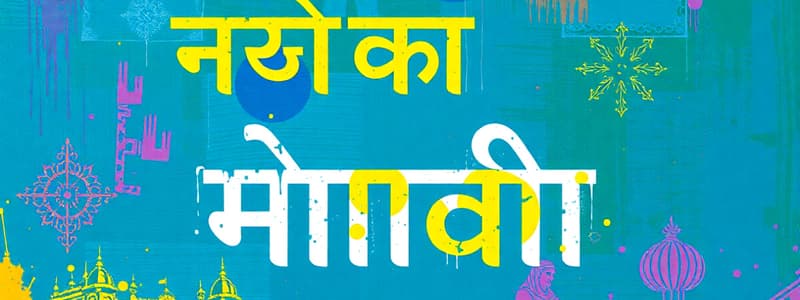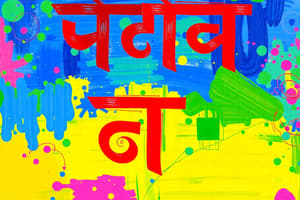Podcast
Questions and Answers
How does the concept of 'Sanskritization' specifically influence the evolution of the Hindi language?
How does the concept of 'Sanskritization' specifically influence the evolution of the Hindi language?
- It leads to the creation of entirely new vocabulary, unrelated to existing Hindi or Sanskrit roots.
- It encourages the replacement of Persian and Arabic loanwords with terms derived from Sanskrit. (correct)
- It standardizes the grammar and syntax of various Hindi dialects to create a uniform language.
- It promotes the integration of English loanwords to modernize the language.
Considering the sociopolitical context of India, what complex challenge arises from promoting Hindi as a national language?
Considering the sociopolitical context of India, what complex challenge arises from promoting Hindi as a national language?
- The over-reliance on Sanskrit, leading to the exclusion of other historical influences on Hindi.
- The standardization of Hindi grammar, potentially diminishing the richness of regional dialects.
- The decreased international recognition of Hindi in global business and diplomacy.
- The risk of alienating non-Hindi speaking populations and potentially undermining national unity. (correct)
What distinguishes Khariboli from other Hindi dialects and why is it considered the foundation for Modern Standard Hindi?
What distinguishes Khariboli from other Hindi dialects and why is it considered the foundation for Modern Standard Hindi?
- Khariboli's isolation from Sanskrit influences preserved its unique linguistic features.
- Khariboli's simplified grammatical structure facilitated easier language learning.
- Khariboli's extensive use of Persian and Arabic loanwords made it more accessible.
- Khariboli's literary tradition and standardization efforts have led to its adoption as the basis for Modern Standard Hindi. (correct)
In what key aspect does Bollywood contribute to both Indian culture and its global presence?
In what key aspect does Bollywood contribute to both Indian culture and its global presence?
Considering India's linguistic diversity, what constitutional provision addresses the use of languages in official government functions?
Considering India's linguistic diversity, what constitutional provision addresses the use of languages in official government functions?
What was the primary motivation behind the standardization of Modern Standard Hindi in the 19th century?
What was the primary motivation behind the standardization of Modern Standard Hindi in the 19th century?
Which linguistic feature of Hindi distinguishes it from purely synthetic languages?
Which linguistic feature of Hindi distinguishes it from purely synthetic languages?
How did the historical presence of Muslim rulers in India significantly shape the evolution of Hindi?
How did the historical presence of Muslim rulers in India significantly shape the evolution of Hindi?
In what fundamental way does the Devanagari script represent vowels, and how does this affect its functionality?
In what fundamental way does the Devanagari script represent vowels, and how does this affect its functionality?
What role did Bharatendu Harishchandra play in the development of Hindi literature?
What role did Bharatendu Harishchandra play in the development of Hindi literature?
Which statement accurately describes the relationship between Hindi and Urdu?
Which statement accurately describes the relationship between Hindi and Urdu?
How does verb conjugation in Hindi reflect a complex interplay of grammatical categories?
How does verb conjugation in Hindi reflect a complex interplay of grammatical categories?
What distinguishes Medieval Hindi literature from Modern Hindi literature in terms of themes and styles?
What distinguishes Medieval Hindi literature from Modern Hindi literature in terms of themes and styles?
Flashcards
What is Bollywood?
What is Bollywood?
The Hindi film industry based in Mumbai.
Hindi's official status
Hindi's official status
One of the official languages of the Union government of India, alongside English.
Examples of Hindi dialects
Examples of Hindi dialects
Khariboli, Braj Bhasha, Awadhi and Bhojpuri.
Sources of Hindi vocabulary
Sources of Hindi vocabulary
Signup and view all the flashcards
What is Sanskritization?
What is Sanskritization?
Signup and view all the flashcards
What is Hindi?
What is Hindi?
Signup and view all the flashcards
Hindi speakers in India
Hindi speakers in India
Signup and view all the flashcards
Origins of Hindi
Origins of Hindi
Signup and view all the flashcards
Modern Standard Hindi
Modern Standard Hindi
Signup and view all the flashcards
Linguistic classification of Hindi
Linguistic classification of Hindi
Signup and view all the flashcards
Analytic Language
Analytic Language
Signup and view all the flashcards
Hindi Phonology
Hindi Phonology
Signup and view all the flashcards
Devanagari Script
Devanagari Script
Signup and view all the flashcards
Study Notes
- Hindi is an Indo-Aryan language spoken chiefly in India
- The official language of the Union government of India
- One of the 22 scheduled languages of India
- The census of 2011 recorded around 528 million people in India as Hindi speakers, roughly 44% of the total population
- Outside India, Hindi is spoken by a significant population in Nepal, Mauritius, Fiji, Guyana, Trinidad and Tobago, Suriname, and the United Arab Emirates
History and Development
- Hindi's origins lie in the medieval Indo-Aryan dialects, particularly the Khariboli dialect of Delhi and surrounding regions
- The development of Hindi was influenced by Persian, Arabic, and Turkic languages due to the historical presence of Muslim rulers in India
- Modern Standard Hindi emerged in the 19th century as a standardized form of Khariboli
- The standardization was largely driven by British administrators and missionaries for administrative and educational purposes
- Bharatendu Harishchandra is considered the father of modern Hindi literature
- The Devanagari script was adopted as the standard writing system for Hindi
Linguistic Features
- Hindi is an Indo-European language, belonging to the Indo-Aryan branch
- Closely related to Urdu; both languages share a common base known as Hindustani
- Hindi grammar is largely based on Sanskrit grammar
- An analytic language: grammatical relations are primarily indicated by postpositions, clitics, and word order
- Has three genders: masculine, feminine, and neuter
- Verb conjugations are influenced by tense, aspect, mood, gender, and number
- Hindi phonology includes aspirated and unaspirated consonants, as well as retroflex consonants
- Loanwords from English are increasingly common in modern Hindi
Devanagari Script
- An alphasyllabary, where each consonant has an inherent vowel
- Vowels can be written as independent letters or as diacritics modifying consonants
- Written from left to right
- The script includes a horizontal line at the top of the letters, connecting them visually
- Also used to write other languages, including Sanskrit, Marathi, and Nepali
Hindi Literature
- Medieval Hindi literature includes Bhakti poetry by poets like Kabir, Surdas, and Tulsidas
- Modern Hindi literature developed in the 19th and 20th centuries, with prominent writers such as Munshi Premchand, Jaishankar Prasad, and Mahadevi Varma
- Hindi literature covers various genres, including novels, short stories, poems, dramas, and essays
Hindi Cinema (Bollywood)
- The Hindi film industry, based in Mumbai (formerly Bombay), is known as Bollywood
- One of the largest film industries in the world
- Hindi cinema plays a significant role in Indian culture and entertainment
- Bollywood films are popular not only in India but also in many other countries
- Hindi film music is an integral part of Bollywood movies and Indian culture
Hindi as an Official Language
- One of the official languages of the Union government of India
- English is the other official language
- The Constitution of India recognizes Hindi as the official language, but also allows for the continued use of English for official purposes
- There has been ongoing debate and discussion about the role and promotion of Hindi as a national language
Dialects of Hindi
- Hindi encompasses a range of dialects and regional variations
- Some of the major dialects include Khariboli, Braj Bhasha, Awadhi, and Bhojpuri
- Khariboli is the basis for Modern Standard Hindi
- Mutual intelligibility between different Hindi dialects can vary
- Bhojpuri, while often considered a dialect of Hindi, is sometimes classified as a separate language
Vocabulary
- Hindi vocabulary draws heavily from Sanskrit and Prakrit
- It also includes loanwords from Persian, Arabic, and English
- The process of Sanskritization involves the adoption of Sanskrit terms to replace loanwords from other languages
- The influence of English on Hindi vocabulary is particularly noticeable in urban areas and modern contexts
Hindi in Education
- Hindi is taught as a compulsory subject in many schools in India
- Hindi is also offered as a subject in universities and colleges
- The Central Hindi Directorate promotes the development and propagation of Hindi
- Various organizations and institutions work to promote the use of Hindi in education and government
Studying That Suits You
Use AI to generate personalized quizzes and flashcards to suit your learning preferences.



